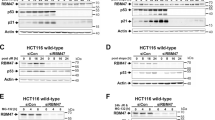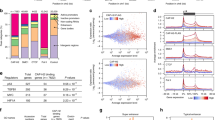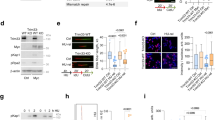Abstract
The different pocket proteins are established as negative cell cycle regulators. With regard to the repressor functions of pocket proteins in cellular senescence, studies so far have mainly focused on pRb/p105. Here, we show that in a broad range of wild-type p53-expressing human tumor cells, and in human diploid fibroblasts, Rb2/p130 is the dominating pocket protein in replicative and in accelerated senescence. Senescent cells are arrested at the transition from late G1- to early S-phase, as indicated by the absence of S- and G2-phase cyclins A and B. Expression of cyclin A and entry into S-phase resumed after RNA interference-mediated knockdown of Rb2/p130. Activation of different upstream pathways by overexpression of either p21 or p16 converged on Rb2/p130 accumulation and induced senescence. In contrast, p53- or p21-negative cells treated with DNA-damaging agents failed to accumulate Rb2/p130 and to enter senescence. Our data suggest that Rb2/p130 is a member of the p53–p21 DNA damage signaling cascade, and represents the essential pocket protein family member needed for the induction of any type of senescence.
This is a preview of subscription content, access via your institution
Access options
Subscribe to this journal
Receive 50 print issues and online access
$259.00 per year
only $5.18 per issue
Buy this article
- Purchase on Springer Link
- Instant access to full article PDF
Prices may be subject to local taxes which are calculated during checkout







Similar content being viewed by others
References
Araki K, Nakajima Y, Eto K, Ikeda MA . (2003). Distinct recruitment of E2F family members to specific E2F-binding sites mediates activation and repression of the E2F1 promoter. Oncogene 22: 7632–7641.
Beausejour CM, Krtolica A, Galimi F, Narita M, Lowe SW, Yaswen P et al. (2003). Reversal of human cellular senescence: roles of the p53 and p16 pathways. EMBO J 22: 4212–4222.
Braig M, Lee S, Loddenkemper C, Rudolph C, Peters AH, Schlegelberger B et al. (2005). Oncogene-induced senescence as an initial barrier in lymphoma development. Nature 436: 660–665.
Brown JP, Wei W, Sedivy JM . (1997). Bypass of senescence after disruption of p21CIP1/WAF1 gene in normal diploid human fibroblasts. Science 277: 831–834.
Bunz F, Dutriaux A, Lengauer C, Waldman T, Zhou S, Brown JP et al. (1998). Requirement for p53 and p21 to sustain G2 arrest after DNA damage. Science 282: 1497–1501.
Chang BD, Broude EV, Dokmanovic M, Zhu H, Ruth A, Xuan Y et al. (1999). A senescence-like phenotype distinguishes tumor cells that undergo terminal proliferation arrest after exposure to anticancer agents. Cancer Res 59: 3761–3767.
Chang BD, Broude EV, Fang J, Kalinichenko TV, Abdryashitov R, Poole JC et al. (2000). p21Waf1/Cip1/Sdi1-induced growth arrest is associated with depletion of mitosis-control proteins and leads to abnormal mitosis and endoreduplication in recovering cells. Oncogene 19: 2165–2170.
Chen Z, Trotman LC, Shaffer D, Lin HK, Dotan ZA, Niki M et al. (2005). Crucial role of p53-dependent cellular senescence in suppression of Pten-deficient tumorigenesis. Nature 436: 725–730.
Cinti C, Macaluso M, Giordano A . (2005). Tumor-specific exon 1 mutations could be the ′hit event′ predisposing Rb2/p130 gene to epigenetic silencing in lung cancer. Oncogene 24: 5821–5826.
Claudio PP, Howard CM, Baldi A, De Luca A, Fu Y, Condorelli G et al. (1994). p130/pRb2 has growth suppressive properties similar to yet distinctive from those of retinoblastoma family members pRb and p107. Cancer Res 54: 5556–5560.
Cobrinik D, Whyte P, Peeper DS, Jacks T, Weinberg RA . (1993). Cell cycle-specific association of E2F with the p130 E1A-binding protein. Genes Dev 7: 2392–2404.
Collado M, Gil J, Efeyan A, Guerra C, Schuhmacher AJ, Barradas M et al. (2005). Tumour biology: senescence in premalignant tumours. Nature 436: 642.
Di Micco R, Fumagalli M, Cicalese A, Piccinin S, Gasparini P, Luise C et al. (2006). Oncogene-induced senescence is a DNA damage response triggered by DNA hyper-replication. Nature 444: 638–642.
Dimri GP, Lee X, Basile G, Acosta M, Scott G, Roskelley C et al. (1995). A biomarker that identifies senescent human cells in culture and in aging skin in vivo. Proc Natl Acad Sci USA 92: 9363–9367.
Gire V, Wynford-Thomas D . (1998). Reinitiation of DNA synthesis and cell division in senescent human fibroblasts by microinjection of anti-p53 antibodies. Mol Cell Biol 18: 1611–1621.
Helmbold H, Deppert W, Bohn W . (2006). Regulation of cellular senescence by Rb2/p130. Oncogene 25: 5257–5262.
Jackson JG, Pereira-Smith OM . (2006). Primary and compensatory roles for RB family members at cell cycle gene promoters that are deacetylated and downregulated in doxorubicin-induced senescence of breast cancer cells. Mol Cell Biol 26: 2501–2510.
Kapic A, Helmbold H, Reimer R, Klotzsche O, Deppert W, Bohn W . (2006). Cooperation between p53 and p130(Rb2) in induction of cellular senescence. Cell Death Differ 13: 324–334.
Khanna KK . (2000). Cancer risk and the ATM gene: a continuing debate. J Natl Cancer Inst 92: 795–802.
Lacy S, Whyte P . (1997). Identification of a p130 domain mediating interactions with cyclin A/cdk 2 and cyclin E/cdk 2 complexes. Oncogene 14: 2395–2406.
Li Q, Sakurai Y, Ryu T, Azuma K, Yoshimura K, Yamanouchi Y et al. (2004). Expression of Rb2/p130 protein correlates with the degree of malignancy in gliomas. Brain Tumor Pathol 21: 121–125.
Mallette FA, Ferbeyre G . (2007). The DNA damage signaling pathway connects oncogenic stress to cellular senescence. Cell Cycle 6: 1831–1836.
Malumbres M, Barbacid M . (2001). To cycle or not to cycle: a critical decision in cancer. Nat Rev Cancer 1: 222–231.
Narita M, Nunez S, Heard E, Narita M, Lin AW, Hearn SA et al. (2003). Rb-mediated heterochromatin formation and silencing of E2F target genes during cellular senescence. Cell 113: 703–716.
Olivier M, Eeles R, Hollstein M, Khan MA, Harris CC, Hainaut P . (2002). The IARC TP53 database: new online mutation analysis and recommendations to users. Hum Mutat 19: 607–614.
Pardee AB . (1974). A restriction point for control of normal animal cell proliferation. Proc Natl Acad Sci USA 71: 1286–1290.
Psyrri A, DeFilippis RA, Edwards AP, Yates KE, Manuelidis L, DiMaio D . (2004). Role of the retinoblastoma pathway in senescence triggered by repression of the human papillomavirus E7 protein in cervical carcinoma cells. Cancer Res 64: 3079–3086.
Ren B, Cam H, Takahashi Y, Volkert T, Terragni J, Young RA et al. (2002). E2F integrates cell cycle progression with DNA repair, replication, and G(2)/M checkpoints. Genes Dev 16: 245–256.
Schmitt CA, Fridman JS, Yang M, Lee S, Baranov E, Hoffman RM et al. (2002). A senescence program controlled by p53 and p16INK4a contributes to the outcome of cancer therapy. Cell 109: 335–346.
Shan B, Chang CY, Jones D, Lee WH . (1994). The transcription factor E2F-1 mediates the autoregulation of RB gene expression. Mol Cell Biol 14: 299–309.
Susini T, Massi D, Paglierani M, Masciullo V, Scambia G, Giordano A et al. (2001). Expression of the retinoblastoma-related gene Rb2/p130 is downregulated in atypical endometrial hyperplasia and adenocarcinoma. Hum Pathol 32: 360–367.
Takahashi A, Ohtani N, Yamakoshi K, Iida S, Tahara H, Nakayama K et al. (2006). Mitogenic signalling and the p16INK4a-Rb pathway cooperate to enforce irreversible cellular senescence. Nat Cell Biol 8: 1291–1297.
Takahashi Y, Rayman JB, Dynlacht BD . (2000). Analysis of promoter binding by the E2F and pRB families in vivo: distinct E2F proteins mediate activation and repression. Genes Dev 14: 804–816.
te Poele RH, Okorokov AL, Jardine L, Cummings J, Joel SP . (2002). DNA damage is able to induce senescence in tumor cells in vitro and in vivo. Cancer Res 62: 1876–1883.
Tosi GM, Trimarchi C, Macaluso M, La Sala D, Ciccodicola A, Lazzi S et al. (2005). Genetic and epigenetic alterations of RB2/p130 tumor suppressor gene in human sporadic retinoblastoma: implications for pathogenesis and therapeutic approach. Oncogene 24: 5827–5836.
Waldman T, Lengauer C, Kinzler KW, Vogelstein B . (1996). Uncoupling of S phase and mitosis induced by anticancer agents in cells lacking p21. Nature 381: 713–716.
Zalvide J, DeCaprio JA . (1995). Role of pRb-related proteins in simian virus 40 large-T-antigen-mediated transformation. Mol Cell Biol 15: 5800–5810.
Zhang B, Chen W, Roman A . (2006). The E7 proteins of low- and high-risk human papillomaviruses share the ability to target the pRB family member p130 for degradation. Proc Natl Acad Sci USA 103: 437–442.
Zhang HS, Gavin M, Dahiya A, Postigo AA, Ma D, Luo RX et al. (2000). Exit from G1 and S phase of the cell cycle is regulated by repressor complexes containing HDAC-Rb-hSWI/SNF and Rb-hSWI/SNF. Cell 101: 79–89.
Zhu L, van den Heuvel S, Helin K, Fattaey A, Ewen M, Livingston D et al. (1993). Inhibition of cell proliferation by p107, a relative of the retinoblastoma protein. Genes Dev 7: 1111–1125.
Acknowledgements
This work was supported by a grant from Deutsche Krebshilfe (German Cancer Aid) to WB. The Heinrich-Pette-Institute is financially supported by Freie und Hansestadt Hamburg and Bundesministerium für Gesundheit.
Author information
Authors and Affiliations
Corresponding author
Additional information
Supplementary Information accompanies the paper on the Oncogene website (http://www.nature.com/onc)
Supplementary information
Rights and permissions
About this article
Cite this article
Helmbold, H., Kömm, N., Deppert, W. et al. Rb2/p130 is the dominating pocket protein in the p53–p21 DNA damage response pathway leading to senescence. Oncogene 28, 3456–3467 (2009). https://doi.org/10.1038/onc.2009.222
Received:
Revised:
Accepted:
Published:
Issue Date:
DOI: https://doi.org/10.1038/onc.2009.222
Keywords
This article is cited by
-
The cell fate: senescence or quiescence
Molecular Biology Reports (2016)
-
p53-dependent gene repression through p21 is mediated by recruitment of E2F4 repression complexes
Oncogene (2014)
-
Silencing of RB1 but not of RB2/P130 induces cellular senescence and impairs the differentiation potential of human mesenchymal stem cells
Cellular and Molecular Life Sciences (2013)
-
Necdin modulates proliferative cell survival of human cells in response to radiation-induced genotoxic stress
BMC Cancer (2012)
-
BRCA1-mutated and basal-like breast cancers have similar aCGH profiles and a high incidence of protein truncating TP53 mutations
BMC Cancer (2010)



